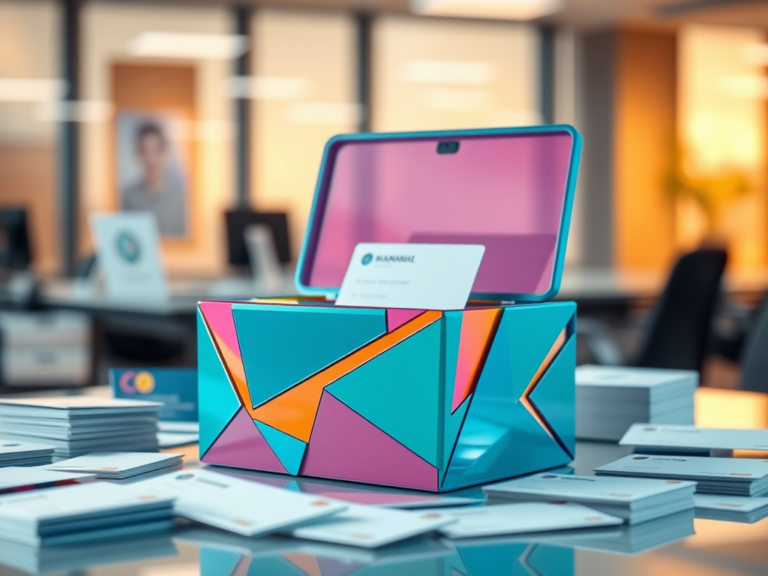
Introduction
Organisation and presentation are critical in today’s hectic corporate environment. Customised, quick, and fashionable methods of storing and presenting your cards are provided by a 3d-printed 500-card business card box. This guide will address everything from materials and design to printing and finishing details, regardless of your level of expertise, a professional looking for a distinctive design or a business owner searching for reasonably priced options.

Selecting the Ideal Filament
The kind of filament you choose will affect the look and lifetime of your cardboard box:
- PLA: Available in many colours, environmentally safe, and simple to print.
- ABS: More heat-resistant and durable, but during printing, it requires ventilation.
- PETG: Strikes a mix of durability and flexibility.
- Resin (SLA): It may be more costly, but it produces smooth, detailed prints.
Optimal Result Printer Settings
Change your slicer settings for a premium 3d-printed business card box:
- Layer height: 0.1-0.2 mm for fine details.
- Infill density: 20–30% for a strong yet light-weight box.
- Print speed: 50mm/s for precision.
- Supports: Enable if your design features overhanging elements.
- Bed adhesion: Use either adhesive solutions or a heated bed (for ABS and PETG).
Detailed Guide on 3D Printing a Business Card Box
Step 1. Either download or design your model.
- Look for a ready-made STL file or design customistically with Fusion 360, Blender, or Tinkercad.
Step 2. Slice the Model.
- Load the file into a slicer program (such as Cura or PrusaSlicer) , then modify the settings for your printer.
Step 3. Prepare the printer.
- To avoid print faults, ensure the printer bed is level and the nozzle is clean.
Step 4. Print the business card box.
- Start the print, checking the first few layers to guarantee smooth printing and adhesion.
Step 5. Post-processing.
- Improve the appearance and lifetime of your printed box.
- Sanding: Use fine-grit sandpaper to smooth rough edges.
- Painting: Use acrylic paints for a polished finish.
- Coating: Apply a protective varnish to boost lifetime.
- Branding: Add your company logo by dual-colour printing, engraving, or sticker application.
Why would one want a 3d-printed business card box?
Personalised business card storage made possible by 3D printing offers:
- Tailor the box to your favourite size, design, and brand.
- 3D printing can be more reasonably priced than buying mass-produced boxes.
- Choose premium fibres for intense and long-lasting casing.
- Use environmentally friendly materials like PLA for a better choice.
Critical Factors Affecting Business Card Box Printing
Remember these key considerations before beginning your 3D printing endeavour:
Choosing the Correct 3d Model
Free and premium STL files for business card boxes are in many 3D model repositories:
- Thingiverse: Free designs created in a community.
- My Mini Factory: Compiled premium models.
- Cults3d: Paid and free choices for outstanding designs.
- Tinkercad: A Customizable online design tool for building your model.
Ideas for Customising Corporate Card Boxes
- Engraved Logos: Emboss your brand’s logo for a professional look.
- Hinged or Sliding Lids: Enhance both style and functionality.
- Multi-Compartment Designs: Keep several business card categories in one box.
- Magnetic Closure: Guarantee safe storage with built-in magnets.
Typical Printing Problems and Solutions
1. Warping or Curling
- Use correct adhesion techniques and a warm bed.
- Reduce print speed and ensure a consistent ambient temperature.
2. Stringing or Oozing
- Slightly lower print temperature and change retraction parameters.
3. Brittle or Weak Prints
- Use a stronger filament, like PETG, or increase the infill density.
- Adjust speed and temperature to ensure layers bond correctly.
READ MORE – The Complete Guide to 3d-Printed Aquarium Decoration Jars: Design Tips, Benefits, and Best Practices
FAQs
1. How long does 3D printing a business card box take?
- Though size and complexity affect printing time, it usually runs between 4 and 8 hours.
2. Can I use a resin printer for a business card box?
- Though it is less durable than FDM prints, resin printing provides smoother details.
3. What is the best filament for a professional-looking card box?
- PLA for simplicity of use, PETG for strength, and resin for high-detail finishing.
4. Can I create a foldable or collapsible business card box?
- Certainly! Modular or hinged designs allow for collapsibility.
5. Is 3D printing a business card box cheaper than buying one?
- 3D printing is usually more affordable for both customised and bulk production.
Conclusion:
Professionals trying to highlight their brand would find a valuable and fashionable solution in a 3d-printed business card box for 500 cards. A good, sturdy, and aesthetically pleasing card holder can be produced with the correct design, materials, and finishing methods. This tutorial provides all the knowledge you need to get started, whether for personal or commercial projects.